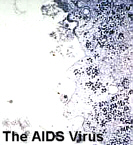Human Immunodeficiency Virus (HIV) is a retrovirus that causes acquired immunodeficiency
syndrome (AIDS). First discovered in 1981, the most common type is HIV-1, but in 1986,
HIV-2 was found. HIV causes a loss of immune function and subsequent
development of opportunistic infections. Approximately 70%
of HIV-infected individuals develop AIDS within 10 years. While there is no evidence of a
cure for AIDS, many of those infected have survived longer than anticipated, and many of
those are asymptomatic. Infection results when the virus binds to CD4 receptors in lymph
nodes and certain central and peripheral nerve cells. This causes their destruction and a
progressive loss of immune function. The first
signs of acute infection are rather vague and include fever, malaise, rash, and
lymphadenopathy. For a
period of 5-10 years, the individual may be asymptomatic--only a steady drop in CD4+T
lymphocytes indicates the infection. Patients then become symptomatic, with low-grade
fevers, night sweats, chronic diarrhea, and peripheral neuropathy. Common during this
stage are vaginal and oral ulcers and shingles. This stage lasts around 3 years, until
AIDS is diagnosed. It is marked by opportunistic infections that people with healthy
immune systems would not be affected by.
Helpful Links:
HIV/AIDS
hile no cure for HIV/AIDS is
known at this time, there are certain herbs that have shown promise in battling this deadly
disease. Echinacea is
believed by some researchers to raise levels of properdin, a natural compound in our bodies.
Properdin sends out infection-fighting white blood cells to block viruses and bacteria.
Echinacea's root extract seems to act like the body's own antiviral compound, interferon.
It has been shown to carry antiviral activity against herpes, influenza, and other viruses
by stimulating the body to make more interferon.
 Another herb that may assist in the fight
against HIV/AIDS is Garlic,
which has proven to be one of the best herbal antibiotics around. Garlic helps combat
many kinds of infections including pneumonia, candidiasis, and herpes, and it acts as an
immune stimulant, as well. Studies in 1988 showed that after consuming garlic, raw or as
an aged extract, the body's natural killer cell activity in the blood doubled.
Another herb that may assist in the fight
against HIV/AIDS is Garlic,
which has proven to be one of the best herbal antibiotics around. Garlic helps combat
many kinds of infections including pneumonia, candidiasis, and herpes, and it acts as an
immune stimulant, as well. Studies in 1988 showed that after consuming garlic, raw or as
an aged extract, the body's natural killer cell activity in the blood doubled.
 St. John's Wort contains
the compound hypericum, which shows promise in fending off opportunistic infections caused
by HIV/AIDS. Because it has antidepressant properties as well as antiviral, this particular
herb may prove to be doubly effective for those suffering with AIDS due to depression that
over half of AIDS sufferers experience.
Andrographis paniculata
seems to
stop unregulated cell growth caused by viruses, which, with regular use has shown some
improvement in HIV patients. The chief substance in
Licorice Root is
glycyrrhizin, which has been studied for its antiviral affects against HIV. The Japanese
have conducted clinical trials on glycyrrhizin, and so far, it has been shown to inhibit
cell infection and induce interferon activity. None of these herbs can be considered a
cure for HIV or AIDS. They are simply healthy alternatives in a war against this deadly
virus.
St. John's Wort contains
the compound hypericum, which shows promise in fending off opportunistic infections caused
by HIV/AIDS. Because it has antidepressant properties as well as antiviral, this particular
herb may prove to be doubly effective for those suffering with AIDS due to depression that
over half of AIDS sufferers experience.
Andrographis paniculata
seems to
stop unregulated cell growth caused by viruses, which, with regular use has shown some
improvement in HIV patients. The chief substance in
Licorice Root is
glycyrrhizin, which has been studied for its antiviral affects against HIV. The Japanese
have conducted clinical trials on glycyrrhizin, and so far, it has been shown to inhibit
cell infection and induce interferon activity. None of these herbs can be considered a
cure for HIV or AIDS. They are simply healthy alternatives in a war against this deadly
virus.
 These
products are available from our
Virtual Store.
Our liberal
Money Back Guarantee applies.
These
products are available from our
Virtual Store.
Our liberal
Money Back Guarantee applies.